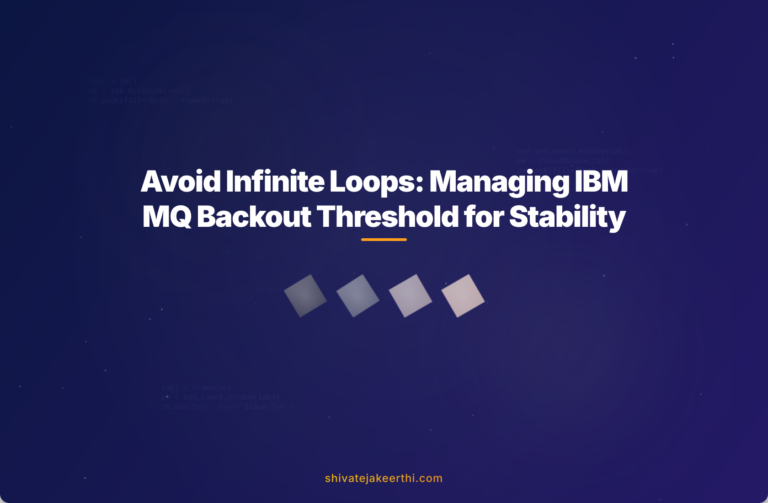IBM MQ is a powerful messaging middleware used to ensure reliable communication between applications in distributed systems. It plays a vital role in securely transferring messages, particularly across financial, retail, and enterprise systems. One crucial aspect developers often grapple with is the handling of message redelivery, specifically when dealing with runtime errors and exceptions. Understanding the BACKOUT_THRESHOLD setting, especially when set to zero, is key to mastering message delivery and system stability.
Setting the BACKOUT_THRESHOLD to 0: What Does It Mean?
In IBM MQ, the BACKOUT_THRESHOLD parameter tells the queue how many times a message can fail processing before the system moves it out of the main input queue into a separate error-handling queue (often called a backout queue). Setting this threshold to zero creates an intriguing scenario, one that’s frequently tested in Java-based applications to understand message redelivery patterns clearly.
Imagine you have a Java application pulling messages from IBM MQ. Your code looks simple and straightforward:
MQQueueManager queueManager = new MQQueueManager("QMGR");
MQQueue queue = queueManager.accessQueue("INQUEUE", MQC.MQOO_INPUT_AS_Q_DEF);
MQGetMessageOptions options = new MQGetMessageOptions();
MQMessage message = new MQMessage();
// pull and process message
queue.get(message, options);
processMessage(message); // your logic here
queue.close();
queueManager.disconnect();
What happens if processMessage() throws a runtime exception? Suppose there’s a bug causing a NullPointerException. With a BACKOUT_THRESHOLD set to zero, IBM MQ continuously returns the problematic message right back to the input queue for processing.
This behavior has both pros and cons. On one hand, it ensures that no messages are inadvertently discarded due to temporary issues. But it also means your application might fall into an infinite loop of retries, particularly dangerous if your application crashes or is forcibly stopped.
Consider a scenario where your application abruptly crashes after a runtime failure. When restarted, it immediately picks up the same problematic message from the queue and crashes again. This cycle continues indefinitely, causing message processing bottlenecks and negatively impacting system resources.
Comparing BACKOUT_THRESHOLD=0 to Non-zero Settings
Setting your BACKOUT_THRESHOLD to a non-zero value—often set at values like 3 or 5—is typically recommended. This gives your application multiple chances to process unreliable messages before safely delivering problematic ones to a backout queue.
For instance, let’s suppose your threshold is set to 3. The message fails to process three times in succession. After reaching the threshold, IBM MQ moves that message to the designated backout queue rather than looping indefinitely.
You can then inspect the problematic messages separately, resolve the underlying data or code issue, and potentially re-insert them back into processing once resolved.
Comparing this with the zero-threshold scenario, the advantage is clear: you avoid infinite processing loops, freeing up computing resources and keeping your queue system healthy.
Strange Behavior and Infinite Retries: Inconsistencies of Threshold 0
It’s a common misconception among MQ developers that setting BACKOUT_THRESHOLD=0 disables the backout mechanism completely or suppresses retries. In reality, the opposite is true. Setting this value to zero essentially disables the backout handling, causing continuous message retries upon failure.
This misunderstanding often leads developers into unexpected loops or infinite retries, causing frustration and performance degradation. Real-world experience underscores the operational nightmare this scenario creates, particularly in high-volume message exchange systems.
IBM’s documentation clearly states the behavior to expect when setting BACKOUT_THRESHOLD to zero, and official guidance strongly recommends assigning an appropriately low but non-zero threshold, unless you’re handling exceptions explicitly in your code.
Configuring Queues for Better Message Management
Fortunately, IBM MQ offers flexibility for configuring message acknowledgment and error-handling behavior:
- BACKOUT_REQUEUE_Q_NAME: Define a dedicated queue for problematic messages once the threshold is eclipsed.
- MQMD BackoutCount: Each message has a “BackoutCount”, incremented on each failed delivery, making it easy for apps to handle problem messages explicitly.
- Application-controlled logic: Developers can explicitly code logic that monitors BackoutCount and takes action based on your business needs.
As an example, within your Java application, you might explicitly check the BackoutCount before proceeding with message processing:
int backoutCount = message.backoutCount;
if(backoutCount >= maxBackoutThreshold) {
moveToBackoutQueue(message);
} else {
processMessage(message);
}
Following this pattern creates a robust way of explicitly handling problematic messages, even when the official BACKOUT_THRESHOLD for the queue is set to a lower or default number.
Recommended Practices for Handling Message Retries
To summarize key recommendations from best practices and common experiences with IBM MQ:
- Avoid setting BACKOUT_THRESHOLD=0 in production environments unless you’re explicitly coding application-logic-based retries.
- Set meaningful BACKOUT_THRESHOLD numbers like 2, 3, or 5 to prevent infinite loops and performance degradation.
- Explicitly define a separate backout queue (BACKOUT_REQUEUE_Q_NAME) to isolate problematic messages effectively.
- In Java applications, regularly check backoutCount values and tailor handling logic accordingly to manage message redelivery explicitly within your application logic.
- Monitor queues proactively via management tools like MQ Explorer or script-based monitoring solutions to quickly detect persistent messaging issues.
By following these guidelines, developers ensure effective and reliable message queuing systems, prevent infinite reprocessing cycles, and maintain performance and reliability.
Summary: Balancing Message Redelivery Robustness and Queue Performance
When working with IBM MQ, the handling of problematic or “poison” messages is integral to maintaining system stability. Setting BACKOUT_THRESHOLD=0 inadvertently creates scenarios that lead to infinite message retries, application hangs, and even service outages.
Instead, assign a meaningful threshold number that allows retries while preserving computational resources and system responsiveness. Clearly defining backout queues and explicitly monitoring backout counts is crucial to ensuring your MQ system works as expected.
Through careful tuning and application-level monitoring, your organization can effectively manage redelivery and message reprocessing scenarios, keeping messaging infrastructure robust, scalable, and responsive.
Have you encountered unexpected message redelivery behavior in your IBM MQ systems? What solutions have you implemented to manage problem messages effectively? Share your experiences or questions in the comments below—we’re always eager to discuss best practices!



0 Comments